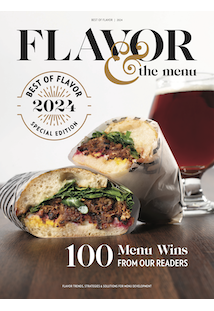
Dish description: Suya beef skewers over maafe peanut stew with maple-braised rainbow carrots, roasted rainbow potatoes, kale and peanut-ginger-miso mushrooms, garnished with ginger-curry chickpeas
Team representative: Godwin Ihentuge, Co-Founder of Yum Village, with locations in Detroit and Cleveland
Can you describe the components of this dish?
GI: In this dish, there were several elements that created a complex and satisfying flavor profile. One of the key components was the beef skewers, which we prepared in a traditional way known as suya, which is a peanut-based dry rub that we apply to the meat with a mixture of crushed peanuts, peanut oil and spices before grilling.
We also created a West African/ Senegalese peanut stew called maafe, based on a mixture of ground peanut butter and a tomato-based stew called obe ata. (We “Americanized” this version a little bit by adding some lemon juice.) It has a very savory, life-changing flavor—the garlic, tomato and onion combined with peppers and spice give a very aromatic display, and the combination of peanut makes it earthy, rich and intoxicating.
How do you use peanuts on your menu?
GI: We use peanuts in a couple of ways at the restaurant—as a dry rub spice that you can apply on different items like suya. We menu an African-style chicken-and-waffle dish: a Belgian waffle with truffle oil greens and Suya Fried Chicken. Another application is maafe, which is utilized a lot on our menu—as a standalone dish, served over rice, or over fries and served as a vegan poutine.








